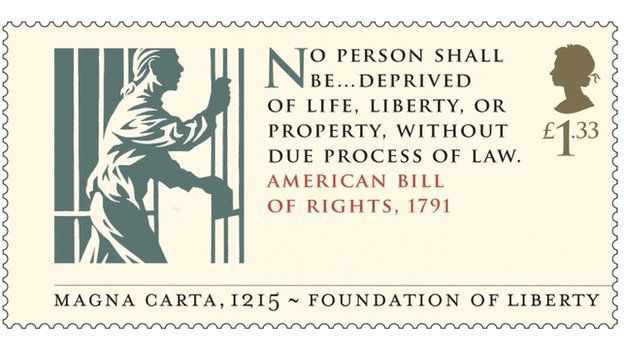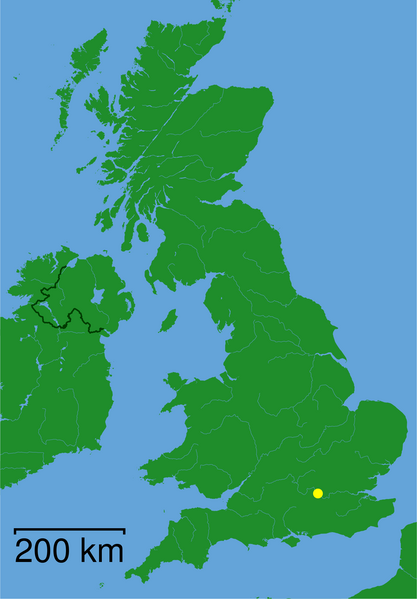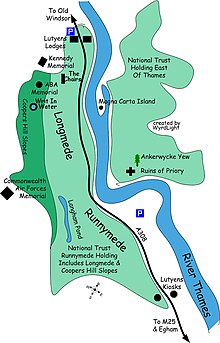A special set of commemorative stamps has been issued to mark the 800th anniversary of the Magna Carta in just under a fortnight's time.
The six stamps feature text from Magna Carta and other charters, bills and declarations that have developed the rule of law around the world.
Magna Carta was granted by King John of England on 15 June 1215, establishing that the king was subject to the law rather than being above it.
A "foundation of liberty" postmark will also appear on letters this week.
Principles set out in Magna Carta charted the right to a fair trial and limits on taxation without representation.
Magna Carta 800th anniversary marked with commemorative stamps
BBC News
2 June 2015

The set of six commemorative stamps mark the 800th anniversary of the Magna Carta
A special set of commemorative stamps has been issued to mark the 800th anniversary of the Magna Carta.
The six stamps feature text from Magna Carta and other charters, bills and declarations that have developed the rule of law around the world.
Magna Carta was granted by King John of England on 15 June 1215, establishing that the king was subject to the law rather than being above it.
A "foundation of liberty" postmark will also appear on letters this week.


Principles set out in Magna Carta charted the right to a fair trial and limits on taxation without representation.
Landmark document
It also inspired a number of other documents, including the US Constitution and the Universal Declaration of Human Rights.
Text from the American Bill of Rights of 1791, the Universal Declaration of Human Rights of 1948, and the 2013 Charter of the Commonwealth are among other texts that feature on the commemorative stamps.
Sir Robert Worcester, chairman of the Magna Carta 800th Committee, said: "The relevance of Magna Carta in the 21st Century is that it is the foundation of liberty.


"I am delighted that Royal Mail has marked this landmark document, and other key bills and declarations it inspired, with these striking stamps. It is fitting that they will be seen by people all around the world."
Andrew Hammond, director of stamps and collectibles at Royal Mail, said the legacy of Magna Carta had been far-reaching.
"The charter's unique status as a fundamental text, guaranteeing freedom under the law, has been the inspiration for many key charters, bills and declarations which have become milestones in the development of the rule of law throughout history and across the world," he said.
Magna Carta 800th anniversary marked with commemorative stamps - BBC News
The six stamps feature text from Magna Carta and other charters, bills and declarations that have developed the rule of law around the world.
Magna Carta was granted by King John of England on 15 June 1215, establishing that the king was subject to the law rather than being above it.
A "foundation of liberty" postmark will also appear on letters this week.
Principles set out in Magna Carta charted the right to a fair trial and limits on taxation without representation.
Magna Carta 800th anniversary marked with commemorative stamps
BBC News
2 June 2015

The set of six commemorative stamps mark the 800th anniversary of the Magna Carta
A special set of commemorative stamps has been issued to mark the 800th anniversary of the Magna Carta.
The six stamps feature text from Magna Carta and other charters, bills and declarations that have developed the rule of law around the world.
Magna Carta was granted by King John of England on 15 June 1215, establishing that the king was subject to the law rather than being above it.
A "foundation of liberty" postmark will also appear on letters this week.


Principles set out in Magna Carta charted the right to a fair trial and limits on taxation without representation.
Landmark document
It also inspired a number of other documents, including the US Constitution and the Universal Declaration of Human Rights.
Text from the American Bill of Rights of 1791, the Universal Declaration of Human Rights of 1948, and the 2013 Charter of the Commonwealth are among other texts that feature on the commemorative stamps.
Sir Robert Worcester, chairman of the Magna Carta 800th Committee, said: "The relevance of Magna Carta in the 21st Century is that it is the foundation of liberty.


"I am delighted that Royal Mail has marked this landmark document, and other key bills and declarations it inspired, with these striking stamps. It is fitting that they will be seen by people all around the world."
Andrew Hammond, director of stamps and collectibles at Royal Mail, said the legacy of Magna Carta had been far-reaching.
"The charter's unique status as a fundamental text, guaranteeing freedom under the law, has been the inspiration for many key charters, bills and declarations which have become milestones in the development of the rule of law throughout history and across the world," he said.
Magna Carta 800th anniversary marked with commemorative stamps - BBC News
Last edited:











